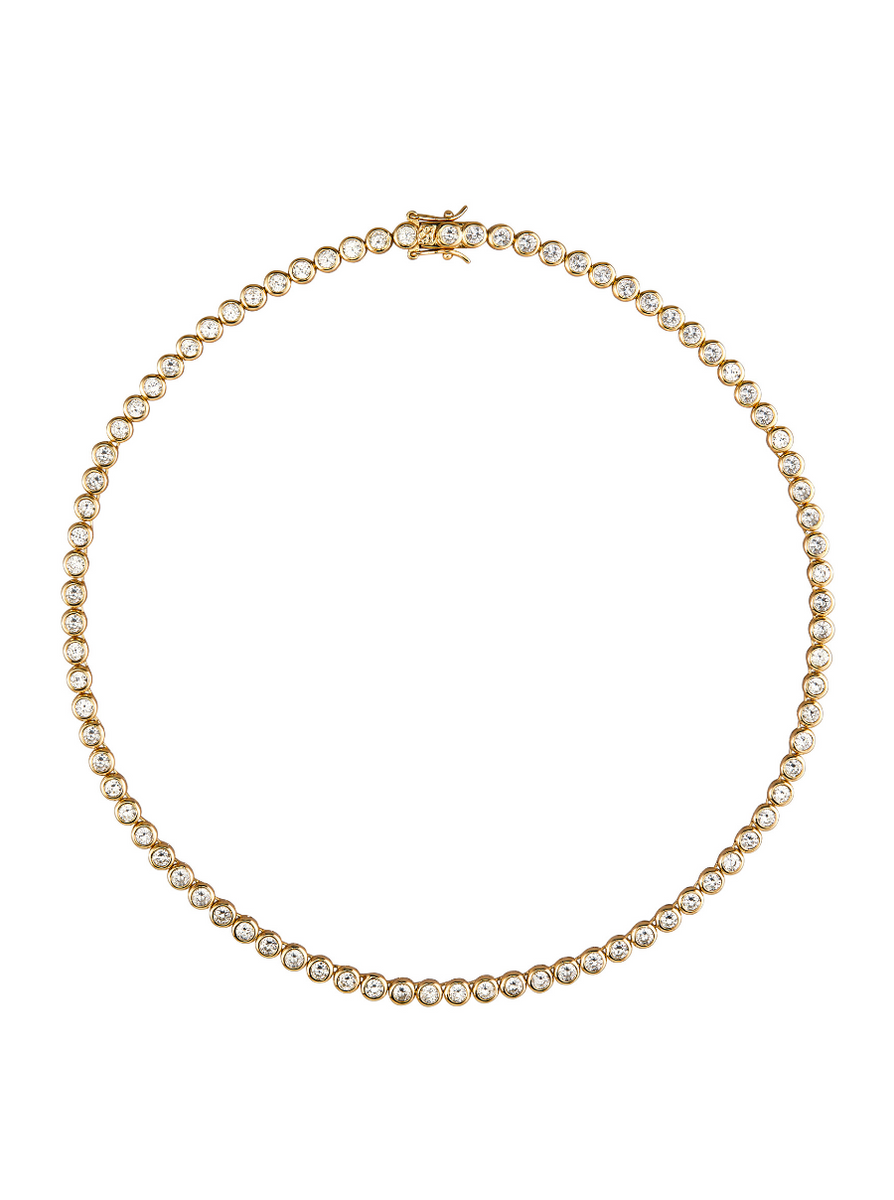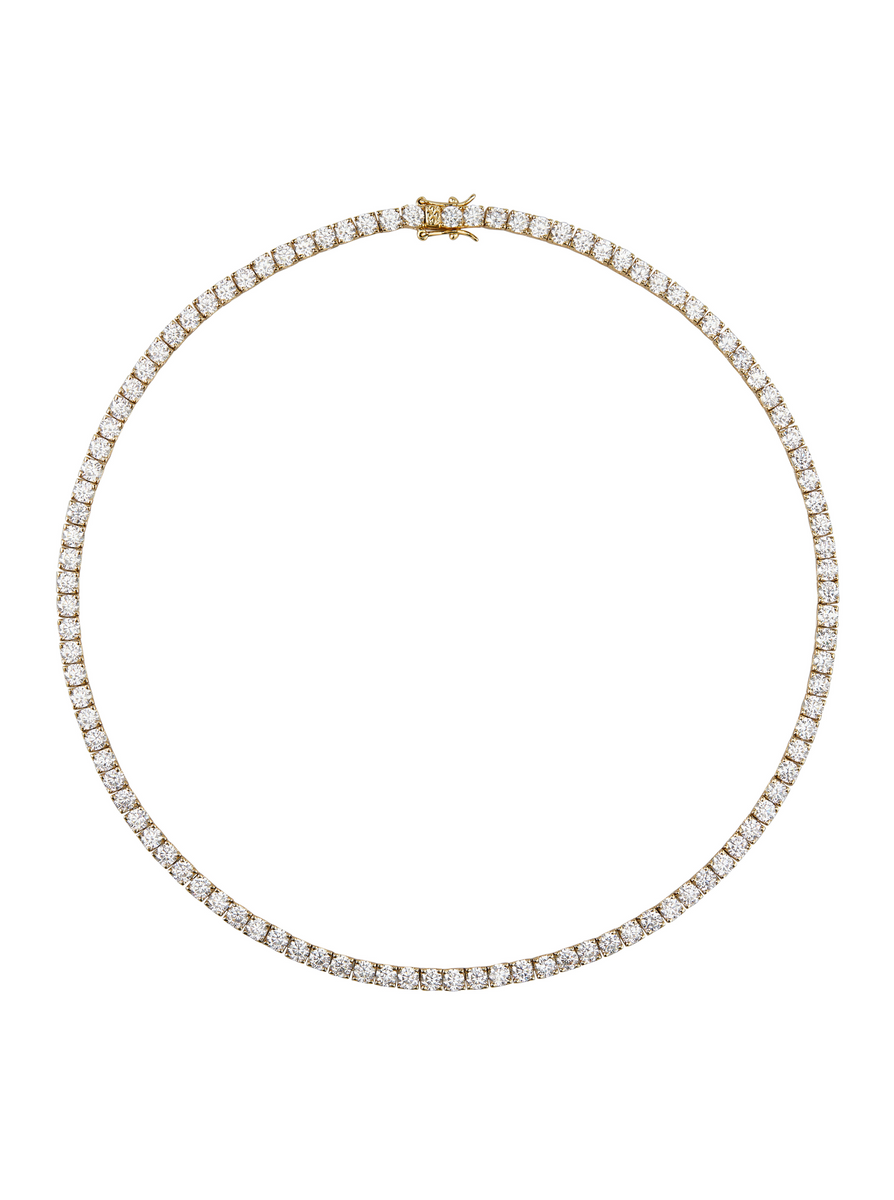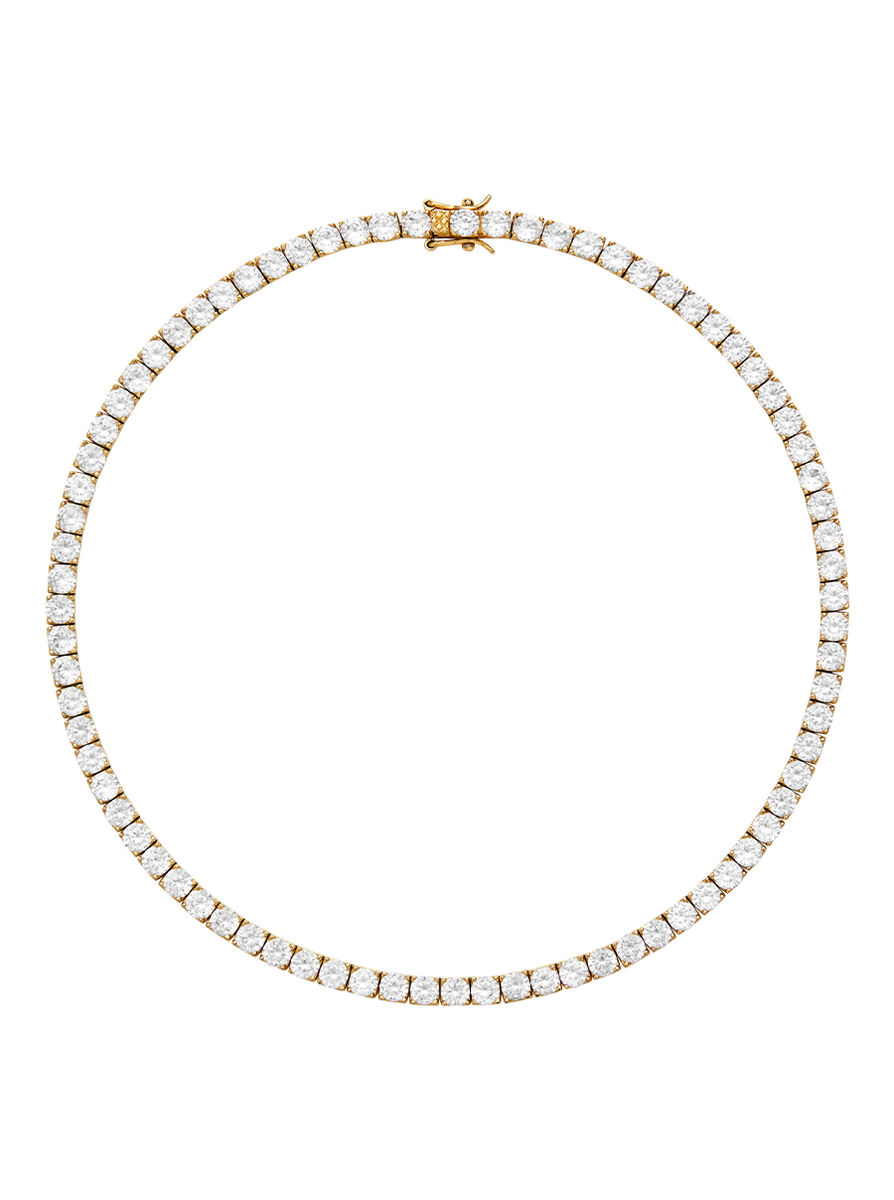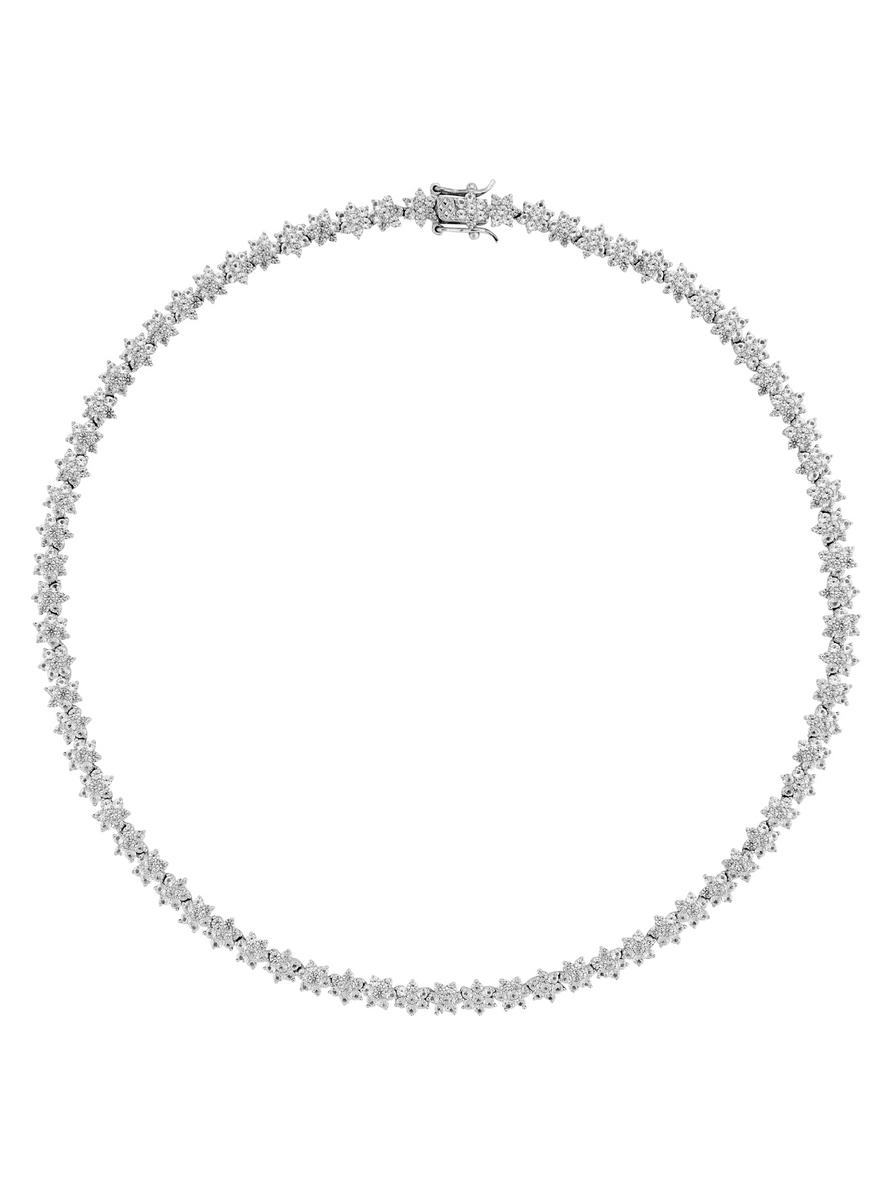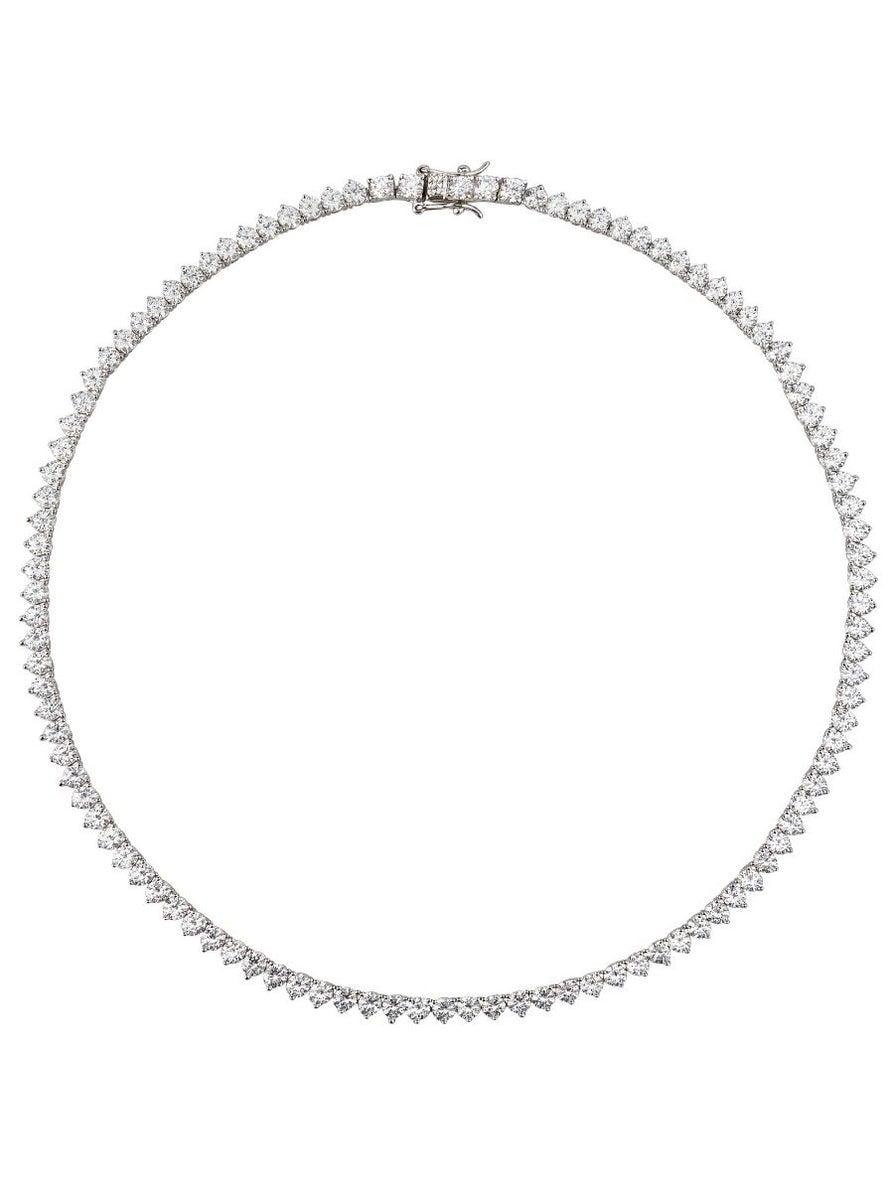How Dorsey Became The Fashion Insider’s Go-To Brand For Tennis Necklaces
All linked products are independently selected by our editors. If you purchase any of these products, we may earn a commission.
Photo: Courtesy of Dorsey.
“For a long time, if you were wearing a tennis necklace, somebody would ask, ‘Is that real or is that fake?’” says jewelry brand Dorsey's founder and CEO, Meg Strachan. “It's basically like asking, ‘What can you afford, or what could the person who gave it to you afford?’”
Prior to the last decade, the purchase options for consumers looking to achieve the single-strand, all-stone look — popularized in the 1980s by American tennis player Chris Evert — were low-quality styles made of cubic zirconia for less than $100 or diamonds for upwards of ten or twenty thousand. After hearing the question more times than she cares to recall, Strachan opted for lab-grown stones instead, to capitalize on the space between those two poles, when launching Dorsey in 2019. Today, the jewelry brand’s Rivière white sapphire tennis necklaces start around $600 depending on metals and stone customization, while its corresponding bracelets start around $300. In 2023, Dorsey sold over 1.7 million lab-grown stones: “The introduction of lab-grown stones democratized people’s ability to wear beautiful jewelry.”
AdvertisementADVERTISEMENT
Since its launch, Dorsey has become known for tennis bracelets and necklaces worn by everyone from Taylor Swift and Bella Hadid to Emily Ratajkowski and Suki Waterhouse, but the brand’s offering is so much greater. “Being known as a Rivière necklace company is such a high compliment, and it's something that we're going to be expanding, but not in a radical way,” Strachan says.
The brand’s other signatures include vintage-inspired designs — like the Lucien, a pair of lever-back drop earrings with a white sapphire stone that borrow from the Art Deco era — are inspired by the memory of Strachan's grandmother, Dorsey, whose essence the brand embodies. “I fell in love with jewelry because of her,” the founder explains.
According to Strachan, Dorsey was a collector with a generous spirit who found an eager recipient in her granddaughter. “The jewelry that my grandmother wore was just the kind of jewelry I’m always looking for: a big beautiful earring, a gorgeous archival-looking bracelet with different colored stones, really beautifully cut stones.” Her grandmother wasn’t handing down oodles of diamonds, sapphires, and rubies; her treasure trove featured more of the costume variety, which, Strachan notes, used to be more comparable to fine jewelry in terms of quality.
Shop This
Strachan had the idea for Dorsey in 2017 while serving as Anine Bing’s chief marketing officer. In a Paris flea market, she found a pair of vintage earrings she liked. Upon picking them up, the back fell off. “I thought, ‘Why doesn't somebody make more affordable pieces that are not high jewelry, but will last as long as we want them to?’” It would take two years before she pursued the idea in earnest.
AdvertisementADVERTISEMENT
While Strachan has always been obsessed with jewelry, she had no professional experience making it. But thanks to her work at direct-to-consumer and e-commerce companies like Girlfriend Collective, Goop, Bandier, and Re/Done, Strachan, who refers to herself as a “merchandiser” rather than a designer, understands how shoppers think and spend their money. “What I've started to notice over time is that a lot of founders of newer companies or companies that think about things differently tend to be outsiders to the industries that they go into,” she says of her untrained but critical eye. With no initial outside funding, she “maneuvered my way into the industry by cold calls and a couple of introductions through friends of friends.” She started with one purchase order of five units, working out of her home in Los Angeles after hours while still full-time at Girlfriend Collective and shortly after having a baby.
Today, the Kate necklace, a classic tennis-inspired style that has graced the necks of Hailey and Justin Bieber, has sold out well over 50 times. In total, Dorsey’s waitlist garnered over 35,000 names last year. But for Strachan, product doesn’t exist in a vacuum. The context in which it’s worn is her favorite part: “Jewelry is given meaning by whoever wears it.”
In ushering in the democratization and subsequent casual-ification of tennis necklaces and bracelets, she’s spawned, or at least capitalized on, a new way of buying and wearing jewelry. For proof, just take a look at her personal-style-oriented Substack What I Put On Today, which sees Strachan — who, on a typical day, wears jeans, a T-shirt, a blazer, and a lab-grown stone necklace — as her own brand's ambassador. “There's a way to get dressed up in just jewelry,” she says. But while she looks ahead to fall — “I like a Rivière necklace and a crew neck sweater” — it’s currently in the midst of New York August. And as thousands patronize the U.S. Open in their finest tennis white and corresponding accessories, many will don a tennis necklace. Our only question for them: “Is that Dorsey?”
AdvertisementADVERTISEMENT
Below, we caught up with Strachan to chat about searching for vintage inspiration, finding confidence, and all things tennis necklaces.
Dorsey’s pieces are vintage-inspired. What are you looking at to spark that inspiration today?
My grandmother got dressed in jewelry first. I tend to do the same thing: If I'm going to go to a black tie event, I'm like, “This ring would go with what dress.” With Dorsey, I think… How is it [going to be] styled? Because jewelry needs the zhuzh of a sleeve or to be layered with a watch. Maybe your hair is pulled back, so you have a specific type of earring.
My grandmother got dressed in jewelry first. I tend to do the same thing: If I'm going to go to a black tie event, I'm like, “This ring would go with what dress.” With Dorsey, I think… How is it [going to be] styled? Because jewelry needs the zhuzh of a sleeve or to be layered with a watch. Maybe your hair is pulled back, so you have a specific type of earring.
I'm [also] completely obsessed with personal style and how people wear things. I would happily sit on a bench in a park and watch people walk by and see how their coat fits them and how they wear their jeans. What type of earring do they wear? How do they stack their earrings? Jewelry is one of the most personal things. It looks like an afterthought, but when you start talking to people or noticing jewelry, what you tend to find, is that it's very deliberate. So I'm inspired by everything. It's movies, it's a girl in a coffee shop and what's on her wrist when she picks up her latte. I stop people all the time to ask them what they're wearing.
Do you have any unexpected examples of things that inspired Dorsey's pieces?
There is a movie called W.E. about Wallis Simpson, who was married to King Edward. I love this movie. When I saw it for the first time, I paused it multiple times to take pictures. The dresses and the jewelry and the parties are so decadent and beautiful.
There is a movie called W.E. about Wallis Simpson, who was married to King Edward. I love this movie. When I saw it for the first time, I paused it multiple times to take pictures. The dresses and the jewelry and the parties are so decadent and beautiful.
AdvertisementADVERTISEMENT
And then I do the total opposite and I'll think about surf culture: “If I'm going to go surfing, how are we bringing diamonds into that setting?” I go between totally different worlds.
Thanks to lab-grown diamonds, tennis necklaces have undergone democratization. You're as likely to see one with a Met Gala red carpet look as a T-shirt and a pair of jeans. A fashion editor in New York will wear it and then my friend who's a nurse in Dallas would wear it. Was that always the intention behind Dorsey?
The jewelry industry is elitist in a lot of ways.
The jewelry industry is elitist in a lot of ways.
When I first started the brand, if you were wearing a tennis bracelet, somebody would say, “Is that real or is that fake?” And it's a really personal question. It's basically like, “What can you afford or what could the person who gave it to you afford?” It's this very polarizing piece of jewelry that used to be [only] available in cubic zirconium or in diamonds.
Because of the number of diamonds that a tennis necklace has, it's one of the most expensive pieces of jewelry. I've gone into so many jewelry stores in my life, and felt so awkward trying something like that on. Universally, using lab-grown diamonds democratizes people wearing beautiful jewelry. It's more accessible to a lot more people.
With Dorsey, we have customers who are buying their first piece of jewelry for $150, and they've saved up for it because they've been coveting it. And then we have customers who are more regular shoppers. We've wanted to create beautiful jewelry for people and more or less remove the aura around jewelry that can make people feel less than. Lab-grown achieves that.
AdvertisementADVERTISEMENT
When you have this process of democratization, it is such a fun thing to see how someone strips something, like a tennis necklace, of its context, and reimagines it.
Everyone wears everything so differently. With jewelry, it's the most fun thing to see. People will stack things in different ways or they don't stack things.
Everyone wears everything so differently. With jewelry, it's the most fun thing to see. People will stack things in different ways or they don't stack things.
Dorsey is meant to surprise and delight and be the package you look forward to. Part of the reason why jewelry has done so well through the last five years is because, during the pandemic, we were all sitting in front of our screens, so we were wearing T-shirts and wanted to put something on that made us feel pulled together.
In a lot of ways, our style has become much more casual, so our jewelry has this casual background to play off of. We're less dressed up than we used to be, so our jewelry is becoming more dressed up. I wear a beautiful big ring and a diamond bracelet with a flat. And also, you're wearing it every day, so the investment is reasonable. And it's a fun thing to collect.
Do you design for yourself or do you design for a "customer"?
We have designers on our team, but I'm not a jewelry designer. I merchandise. I think most about how [a piece] is going to be worn. The team and I are always thinking through how it will be worn or what it will be worn with or where [the customer wearing it is] going. Sometimes we design around a color or a concept. So in a sense, I definitely end up designing for myself, but we have so many people on the team now that have such great input that we [at the same time] end up designing for the Dorsey customer in terms of how and where we think people are going to wear it and what they're going to be inspired by.
We have designers on our team, but I'm not a jewelry designer. I merchandise. I think most about how [a piece] is going to be worn. The team and I are always thinking through how it will be worn or what it will be worn with or where [the customer wearing it is] going. Sometimes we design around a color or a concept. So in a sense, I definitely end up designing for myself, but we have so many people on the team now that have such great input that we [at the same time] end up designing for the Dorsey customer in terms of how and where we think people are going to wear it and what they're going to be inspired by.
AdvertisementADVERTISEMENT
In reading past interviews of yours, confidence seemed to have this huge presence in your career path. How important is it in business? And how does it tie into having an idea that you truly believe in?
I think the lesson is doing things when you don't have confidence, because most of this journey has been moments of no confidence. I saw a quote [by Alex Hormozi] while scrolling on Instagram that changed my life. It said, “You don’t become confident by shouting affirmations in the mirror, but by having a stack of undeniable proof that you are who you say you are.” You build confidence by doing the work and realizing as you're doing it that you're doing it, and that is a really difficult thing to do. It's near-impossible. Everyone's struggling with confidence and comparison, and comparison definitely is the thief of joy. It's also the thief of good ideas, because you end up feeling like something's already been done. The best story about Dorsey is that the first company I asked to create a Rivière necklace for me said, “This has already been done. Why would you do it again?” If I had listened, the company wouldn't exist.
I think the lesson is doing things when you don't have confidence, because most of this journey has been moments of no confidence. I saw a quote [by Alex Hormozi] while scrolling on Instagram that changed my life. It said, “You don’t become confident by shouting affirmations in the mirror, but by having a stack of undeniable proof that you are who you say you are.” You build confidence by doing the work and realizing as you're doing it that you're doing it, and that is a really difficult thing to do. It's near-impossible. Everyone's struggling with confidence and comparison, and comparison definitely is the thief of joy. It's also the thief of good ideas, because you end up feeling like something's already been done. The best story about Dorsey is that the first company I asked to create a Rivière necklace for me said, “This has already been done. Why would you do it again?” If I had listened, the company wouldn't exist.
The other quote that was impactful to my life was from a woman [Jane Marczewski] that I saw on America's Got Talent. She was dying of cancer, and she said, “Don’t you want to see what happens if you don't give up?” And I was like, “Holy shit.” That was one of the most profound things I'd ever heard anyone say. It's something that I'm going to tell my daughter.
AdvertisementADVERTISEMENT
And then I think you have to be okay with failure. My dad once asked me, “What are you afraid of?” I said, “I'm afraid of failing.” He asked if I could handle it if I failed, and I said “yes.” And he said, “Then you don't have anything to be afraid of.” If you're willing to walk the plank, you get to find out where you can go.
This interview has been edited for length and clarity.
AdvertisementADVERTISEMENT








